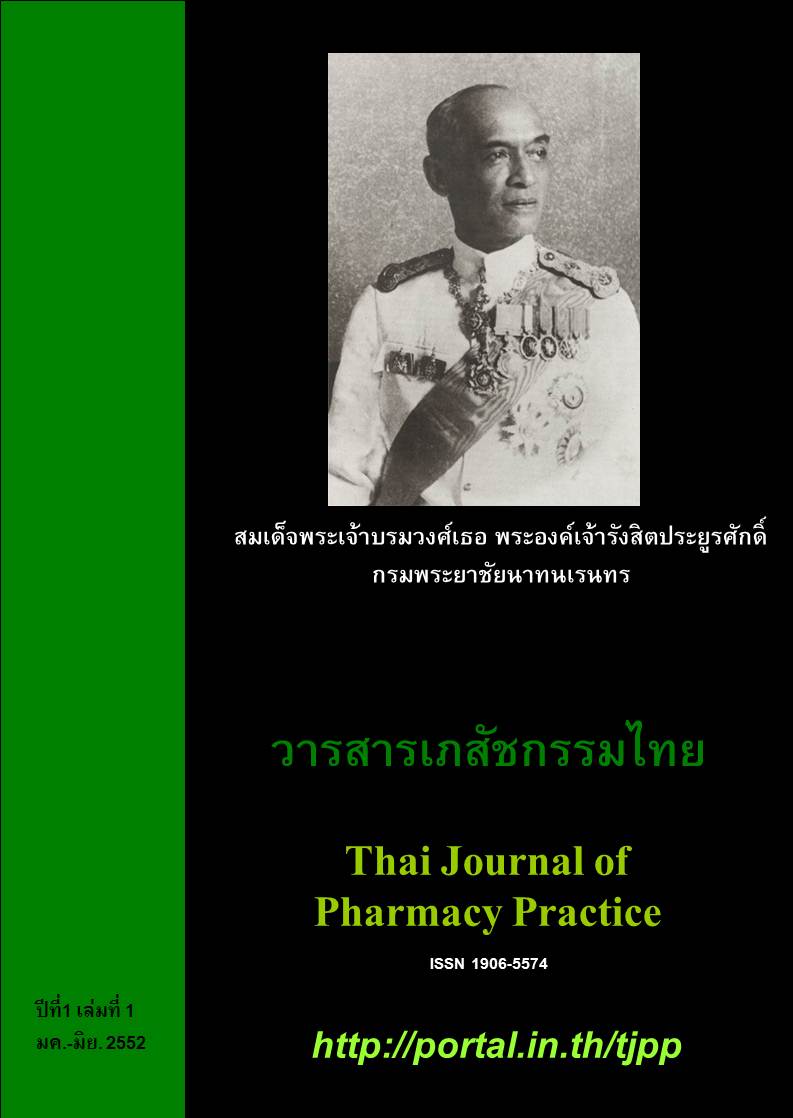ภาวะบีบคั้นทางจริยธรรม ตอนที่ 2: การทบทวนวรรณกรรมในเรื่องการวัด
Main Article Content
บทคัดย่อ
บทความมีสองตอน ตอนแรกทบทวนวรรณกรรมเรื่องภาวะบีบคั้นเชิงจริยธรรมในประเด็นของนิยาม ขนาดปัญหา ตัวแปรเหตุ และผลที่ตามมา บทความตอนที่สองจะกล่าวถึงเรื่องการวัดตัวแปรดังนี้ ในปี 2002 นาธานเนียลนิยามภาวะบีบคั้นเชิงจริยธรรมว่าเป็น “ความปวดร้าวเมื่อบุคคลทราบว่าตนเองตกอยู่ในสถานการณ์ที่มีปัญหาทางจริยธรรม และเชื่อว่าตนต้องรับผิดชอบกับสถานการณ์นั้น พร้อมกับได้ตัดสินใจแล้วว่าการกระทำที่ถูกต้องควรเป็นอย่างไร แต่มีอุปสรรคทั้งที่เกิดขึ้นจริง หรืออุปสรรคในการรับรู้ของตนทำให้ต้องทำในสิ่งที่ตนเชื่อว่าเป็นสิ่งผิด” ภาวะบีบคั้นเชิงจริยธรรมเป็นปัญหาที่พบมากในวิชาชีพพยาบาล การศึกษาในอดีตพบว่าพยาบาลร้อยละ 33-80 กล่าวว่าตนเผชิญกับปัญหานี้ นอกจากนี้พยาบาลที่ลาออกจากงานร้อยละ 15-26 กล่าวว่าตนลาออกจากงานเนื่องจากปัญหานี้ ภาวะบีบคั้นเชิงจริยธรรมเกิดจากสามสาเหตุใหญ่คือ สถานการณ์ทางคลินิก ปัจจัยที่เกี่ยวกับตัวผู้ให้การพยาบาลเอง และปัจจัยแวดล้อมที่ ไม่เกี่ยวกับตัวผู้ให้การพยาบาล บทความยังกล่าวถึงผลกระทบเชิงลบของภาวะบีบคั้นเชิงจริยธรรมต่อสุขภาพกายและใจ คุณภาพการรักษาพยาบาล ความยึดมั่นในเรื่องจริยธรรม ความเหนื่อยหน่ายต่องาน ความพึงพอใจในงาน และการลาออกจากงาน
Article Details
ผลการวิจัยและความคิดเห็นที่ปรากฏในบทความถือเป็นความคิดเห็นและอยู่ในความรับผิดชอบของผู้นิพนธ์ มิใช่ความเห็นหรือความรับผิดชอบของกองบรรณาธิการ หรือคณะเภสัชศาสตร์ มหาวิทยาลัยสงขลานครินทร์ ทั้งนี้ไม่รวมความผิดพลาดอันเกิดจากการพิมพ์ บทความที่ได้รับการเผยแพร่โดยวารสารเภสัชกรรมไทยถือเป็นสิทธิ์ของวารสารฯ
เอกสารอ้างอิง
2) McDowell I, Newell C.. Measuring health: a guide to rating scales and questionnaires. Oxford: Oxford University Press; 1996.
3) Corley MC, Selig P. Prevalence of principled thinking by critical care nurses. Dimens Crit Care Nurs 1994;13:96–103.
4) Kälvemark-Sporrong S, Höglund AT, Hansson MG, Westerholm P, Arnetz B.”We are white coats whirling round”–moral distress in Swedish pharmacies. Pharm World Sci 2005; 27:223-9.
5) Hanna DR. Moral distress redefined: the lived experience of moral distress of nurses who participated in legal, elective, surgically induced abortions [dissertation]. Boston: Boston College; 2002.
6) Decker F. Socialization and interpersonal environment in nurses' affective reactions to work. Soc Sci Med 1985;20:499-509.
7) Corley MC. Moral distress of critical care nurses. Am J Crit Care 1995;4:280-5.
8) Corley MC, Minick P, Elswick RK, Jacobs M. Nurse moral distress and ethical work environment. Nurs Ethics 2005;12:381-90.
9) Kälvemark-Sporrong S, Höglund AT, Arnetz B. Measuring moral distress in pharmacy and clinical practice. Nurs Ethics 2006;13:416-27.
10) Glasberg AL, Eriksson S, Dahlqvist V, Lindahl E, Strandberg G, Soderberg A, et al. Development and initial validation of the Stress of Conscience Questionnaire. Nurs Ethics 2006;13:633-48.
11) Nunnally J, Bernstein I. Psychometric Theory. New York: McGraw Hill; 1994.
12) Jameton A. Nursing Practice: The Ethical Issues. Englewood Cliffs, NJ: Prentice-Hall; 1984.
13) Corley M, Jacobs M, Minick P. Ethical work environment, nurse moral distress, and patient satisfaction with participation in treatment decision making [Abstract] . In: Proceedings of the Association for Health Services Research Annual Meeting; 2000 Jun 26; Los Angeles, CA.
14) Corley MC, Elswick RK, Gorman M, Clor T. Development and evaluation of a moral distress scale. J Adv Nurs 2001;33:250-6.
15) Glasberg AL, Eriksson S, Norberg A. Burnout and 'stress of conscience' among healthcare personnel. J Adv Nurs 2007;57:392-403.
16) Gastmans C. The care perspective in health care ethics. In: Davis A, Tschudin V, De Raeve T, editors. Essentials of teaching and learning in nursing ethics. Edinburgh: Elsevier; 2006. p.135-48.


